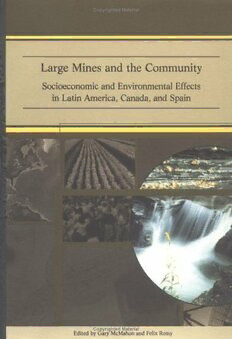
Large Mines and the Community: Socioeconomic and Environmental Effects in Latin America, Canada, and Spain PDF
344 Pages·2002·17.907 MB·English
Most books are stored in the elastic cloud where traffic is expensive. For this reason, we have a limit on daily download.
Preview Large Mines and the Community: Socioeconomic and Environmental Effects in Latin America, Canada, and Spain
Description:
For centuries, communities have been founded or shaped based upon their access to natural resources and today, in our globalizing world, major natural resource developments are spreading to more remote areas. Mining operations are a good example: they have a profound impact on local communities and are often the first industry in a remote region. However, whereas an enormous amount has been written about the macroeconomic effects of the mining industry, there has been practically no in-depth analysis of the comprehensive effects of large mines on their host communities, especially in developing countries. In this book, researchers from Bolivia, Chile, and Peru present and analyze the environmental, cultural, and socioeconomic effects of large mining operations in their respective countries, as well as the processes that led to the observed effects. It presents a case study of the longest continually operating mine in the world - the Almad?n mercury mine in Spain. It also presents an overview of the experience of mining communities in Canada, one of the most important mining countries of the 20th century. A synthesis chapter draws together recommendations for best practice, intended to provide guidance to communities, companies, and governments for future and ongoing mining and other natural resource developments.
See more
The list of books you might like
Most books are stored in the elastic cloud where traffic is expensive. For this reason, we have a limit on daily download.
